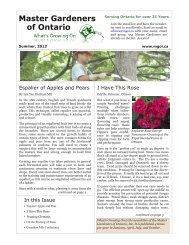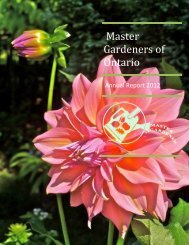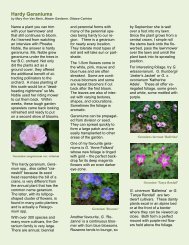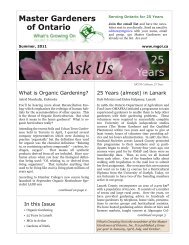Spring 2010 - Master Gardeners of Ontario
Spring 2010 - Master Gardeners of Ontario
Spring 2010 - Master Gardeners of Ontario
Create successful ePaper yourself
Turn your PDF publications into a flip-book with our unique Google optimized e-Paper software.
Page 2<br />
Victoria Day continued from Page 1<br />
Onions and garlic are a special case. They need<br />
cool weather to produce the foliage which will<br />
provide the energy for the bulbs that start forming<br />
when day length begins to shorten in late June.<br />
Garlic is very hardy and I plant it in late October<br />
for the next year’s crop.<br />
Frosthardy vegetables such as lettuce, onions, peas<br />
and spinach can be planted outdoors as soon as the<br />
ground can be worked, <strong>of</strong>ten the first week <strong>of</strong> April<br />
in Ottawa. Semifrosthardy vegetables such as<br />
beets, carrots, chard and potatoes are best planted<br />
in late April or early May as they germinate slowly<br />
in cold soil.<br />
So what happens if the weather turns really nasty?<br />
One year I had peas that were about 10 cm high<br />
when we had a late snowfall <strong>of</strong> 20 cm. Once the<br />
snow was melted the peas were still growing with<br />
no problem. I have had potato foliage frozen to<br />
ground level – it didn’t take them long to spring<br />
back with fresh growth from the roots. Onions and<br />
spinach take frost in their stride.<br />
Some gardeners try to get a head start on the season<br />
with relatively tender plants such as tomatoes.<br />
While gardening is not a competitive sport, there<br />
are those who take a certain amount <strong>of</strong> pride in<br />
having the first juicy red tomato on the block. I<br />
may plant a few tomatoes two or three weeks before<br />
Victoria Day but I spread my risks by planting<br />
the main crop when it is warmer.<br />
Raised beds and well drained soil assist an early<br />
start by warming up much faster. In order to determine<br />
if soil is workable, take a handful and<br />
squeeze – if it stays together in a ball it is still too<br />
wet, if it crumbles it is ready. Time to get out and<br />
get planting!<br />
President: James Lee – president@mgoi.ca<br />
Treasurer: Wendy Fletcher – treasurer@mgoi.ca<br />
Corporate Secretary: Linda Hugli – secretary@mgoi.ca<br />
Directors:<br />
Zone 1: Ralph Bullough – zone1@mgoi.ca<br />
Zone 2: Linda Hugli – zone2@mgoi.ca<br />
Zone 3: vacant<br />
Zone 4: Ann Ironside zone4@mgoi.ca<br />
Zone 5: June Streadwick – zone5@mgoi.ca<br />
MGOI Board <strong>of</strong> Directors<br />
<strong>Master</strong> <strong>Gardeners</strong> <strong>of</strong> <strong>Ontario</strong> <strong>Spring</strong> <strong>2010</strong><br />
No Dig Vegetables<br />
Editors<br />
Digging a garden every year, is not practiced by all<br />
vegetable gardeners. Growing numbers employ “no<br />
dig” methods. In the 70’s Ruth Stout wrote articles<br />
about growing vegetables under a thick layer <strong>of</strong><br />
straw. She never dug, watered or used harsh chemicals.<br />
She just planted and picked. There is a<br />
UTube video about her which you should watch because<br />
it’s a hoot. A more recent proponent, Patricia<br />
Lanza in her books on “lasagna gardening” recommends<br />
layering various types <strong>of</strong> organic matter in<br />
raised beds. She suggests growing vegetables year<br />
after year, never digging or walking on the beds<br />
and adding new organic matter to the top. Permaculture<br />
enthusiasts use similar techniques. Mel<br />
Bartholomew in his popular square foot gardening<br />
books even recommends ignoring the native soil<br />
and planting in his growing medium in raised beds<br />
above the soil. These no dig methods promise high<br />
yields, less work, and natural management <strong>of</strong> insects<br />
and diseases.<br />
Net Resouces<br />
Editors<br />
The net is full <strong>of</strong> great sources <strong>of</strong> vegetable gardening<br />
information. It is also full <strong>of</strong> information<br />
which is not very useful so some patience is needed<br />
while looking. Videos are available for those with a<br />
high speed connection. For example, the Royal<br />
Horticultural Society <strong>of</strong> the UK has a number <strong>of</strong><br />
good videos on vegetables. Alan Titmarsh has also<br />
created a number <strong>of</strong> videos for the BBC on gardening.<br />
Garden Girl also has useful videos. The Peterborough<br />
Group has a number <strong>of</strong> basic fact sheets<br />
on vegetable growing on their website.<br />
Zone 6: Valerie Liney – zone6@mgoi.ca<br />
Zone 7: Jeanne Stoness – zone7@mgoi.ca<br />
Zone 8: Kelly Noel – zone8@mgoi.ca<br />
Zone 9: Don Nicholson – zone9@mgoi.ca<br />
Zone 10: Vacant<br />
Zone 11: John Craw zone11@mgoi.ca<br />
Newsletter: Dianne & Gary Westlake – editors@mgoi.ca<br />
MG Listserve: Kelly Noel – listcoordinator@mgoi.ca<br />
OMAFRA Representative: Helen Scutt – omafra@mgoi.ca<br />
Provincial Administrator:Charlotte Vorstermans – info@mgoi.ca 113 Mill Street, Creemore, ON L0M 1G0<br />
Director at Large: Charlie Dobbin – charlied@rogers.com<br />
Landscape <strong>Ontario</strong> Rep: Denis Flanagan – dflanagan@landscapeontario.com






